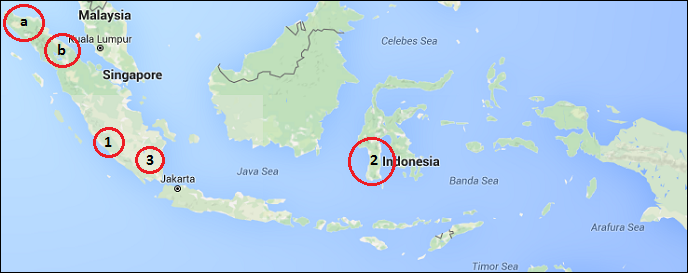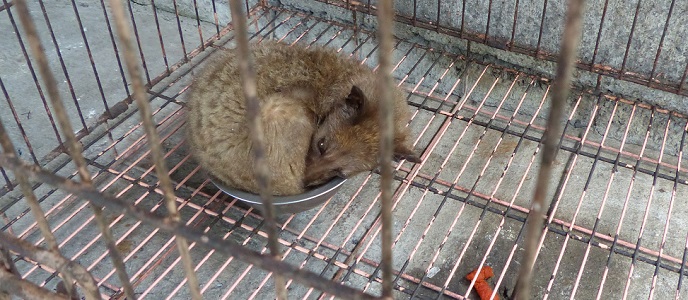Coffee
Coffee is an important beverage in most societies around the globe. Not only for consumers' delight of drinking it but also for its economic value for the coffee bean producing and exporting countries (such as Indonesia). By some this product, made from roasted beans of the coffee plant (flowering plant of the Rubiaceae family), is called the world's "second most legally traded commodity" in human history.
Coffee that is sold on the world market is usually a combination of roasted beans of two botanic types: arabica and robusta. The difference between these two types mainly lies in its taste and the level of caffeine. Arabica beans, more expensive on the world market, have a milder taste and contain approximately 70 percent less caffeine than robusta beans.
The subtropical and equatorial regions provide good conditions for coffee to be grown. Therefore, countries that dominate the world's coffee production are found in South America, Africa, and Southeast Asia.
Coffee is a traded commodity on major futures and commodity exchanges, most importantly in London and New York. Below, are two tables that indicate the top five coffee producing countries and the top five coffee exporting countries.
Top 5 Coffee Bean Producers in Crop Season 2016-2017:
| 1. Brazil | 55,000,000 |
| 2. Vietnam | 25,500,000 |
| 3. Colombia | 14,500,000 |
| 4. Indonesia | 11,491,000 |
| 5. Ethiopia | 6,600,000 |
Top 5 Coffee Bean Exporting Countries in 2016-2017 Season:
| 1. Brazil | 34,500,000 |
| 2. Vietnam | 23,200,000 |
| 3. Colombia | 12,800,000 |
| 4. Indonesia | 6,891,000 |
| 5. Honduras | 5,589,000 |
in bags of 60 kilogram
Source: International Coffee Organization
Coffee in Indonesia
Domestic Production, Export and Consumption of Indonesian Coffee
Indonesia is among the world's top coffee producing and exporting countries. Most of production constitutes the lower quality robusta type. Indonesia is also famous for having a number of specialty coffees such as 'kopi luwak' (known as world's the most expensive coffee) and 'kopi Mandailing' (see below). Regarding agricultural commodities, coffee is Indonesia's fourth-largest foreign exchange earner palm oil, rubber and cocoa.
Coffee was introduced to the archipelago by the Dutch who initially planted coffee trees around their stronghold of Batavia but quickly expanded coffee production to the Bogor and Sukabumi regions in West Java in the 17th and 18th century. Indonesia proved to have a near ideal climate for coffee production, hence plantations were soon established on other parts of Java and on the islands of Sumatra and Sulawesi.
Today, Indonesia's coffee plantations cover a total area of approximately 1.24 million hectares, 933 hectares of robusta plantations and 307 hectares of arabica plantations. More than 90 percent of total plantations are cultivated by small-scale growers who own relatively small plantations of about 1-2 hectares, each. Contrary to competitors such as Vietnam, Indonesia does not have big coffee plantations and therefore encounters more difficulties to safeguard stable production volumes and quality, hence its output loses some competitiveness on the international market.
As mentioned above, and similar to regional coffee giant Vietnam, the bulk of Indonesia's coffee bean production consists of the lower-quality robusta type. The higher quality arabica beans mostly come from South American countries such as Brazil, Colombia, El Salvador and Costa Rica. As such, the bulk of Indonesia's coffee exports (roughly 80 percent) consist of robusta beans. Exports of processed coffee are only a small fraction of total Indonesian coffee exports.
Provinces that account for most of Indonesia's coffee production are:
| Robusta | Arabica |
| 1. Bengkulu (Sumatra) | a. Aceh (Sumatra) |
| 2. South Sulawesi | b. North Sumatra |
| 3. Lampung (Sumatra) |

Starting from the 1960s, Indonesia has shown a small but stable increase in domestic production of coffee. However, according to data from Statistics Indonesia, the size of coffee estates in Indonesia are in decline as farmers have shifted their focus to products from the oil palm (such as crude palm oil and palm kernel), rubber and cocoa which all have higher yields on the international market. Coffee estates - or parts of such estates - have thus been transformed into plantations of other commodities.
In 2012, approximately 70 percent of Indonesia's total annual coffee bean production was exported, mainly to customers in Japan, South Africa, Western Europe and the USA. However, as Indonesia's domestic consumption of coffee has been growing, exports have declined. Coffee consumption in Indonesia rose by a Compound Annual Growth Rate (CAGR) of 7.7 percent in the years 2011-2014. Still, at 1.0 kilogram (2014 data), per capita consumption of coffee remains low in Indonesia.
Indonesian Coffee Production & Export:
| 2014 | 2015 | 2016 | 2017 | 2018 | |
| Production (in 1,000 tons) |
712 | 550 | 664 | 669 | 674¹ |
| Export (in 1,000 tons) |
383 | 350 | 400¹ | ||
| Export (in billion USD) |
1.03 | 1.19 | 1.36¹ |
| 2008 | 2009 | 2010 | 2011 | 2012 | 2013 | |
| Production (in 1,000 tons) |
698 | 683 | 687 | 634 | 748 | 740 |
| Export (in 1,000 tons) |
491 | 518 | 440 | 354 | 520 | 460 |
| Export (in billion USD) |
1.08 | 0.88 | 0.86 | 1.09 | 1.53 | n.a. |
¹ indicates estimate
Source: Asosiasi Eksportir dan Industri Kopi Indonesia (AEKI)
Domestic Coffee Consumption Indonesia:
| 2011 | 2012 | 2013 |
2014 | 2015 | 2016 | 2017¹ | |
| Consumption (in 1,000 60 kg bags) |
3,333 | 3,584 | 4,042 | 4,167 | 4,333 | 4,500 | 4,600 |
Source: International Coffee Organization
Indonesian Specialty Coffees
Besides the production of regular coffee, Indonesia also produces several specialty coffees. Most famous of these specialties are luwak coffee (kopi luwak), Toraja coffee, Aceh coffee and Mandailing coffee. The first one - luwak coffee - is possibly the most famous type of coffee as it is known as the world's most expensive coffee. It is brewed from beans that have passed through the digestive system of the Asian palm civet (catlike animal). Due to this special fermentation process inside the animal (and due to the fact that the civet is able to select the juiciest coffee cherries) this coffee is believed to have a richer taste. Its labor-intensive production process and scarcity on the international market cause its expensive price.

Future Prospects of Indonesian Coffee
According to data from the Indonesian Coffee Exporters Association (AEKI), Indonesian farmers in cooperation with the relevant ministries are planning to expand Indonesia's coffee plantations, while rejuvenating old plantations through intensification programs. By increasing acreage, Indonesia's coffee production in the coming ten years is targeted to reach between 900,000 and 1.2 million tons per year. As both global and domestic demand is rising, investment in the country's coffee sector is needed. Besides increasing quantity of the beans, quality is also expected to increase due to technological innovations. However, coffee production per hectare is still low compared to other large coffee producing countries. In 2015, Indonesia produces 741 kilogram of robusta beans per hectare and 808 kilogram of arabica beans per hectare. In Vietnam this figure stands at 1,500 kilogram per hectare and in Brazil at 2,000 kilogram.
Coffee Price:
In the 2014-2015 harvest season there was a global shortage of 6.4 million bags of coffee beans (resulting in sharply rising coffee prices in 2014). This shortage was caused by the combination of increasing coffee consumption in emerging markets and falling coffee output on the back of weather-related causes. In the 2015-2016 season the coffee shortage may fall to 3.5 million bags. Despite this shortage, coffee prices have declined in 2015 as Brazil's currency depreciated severely against the US dollar.
Updated on 13 November 2017
